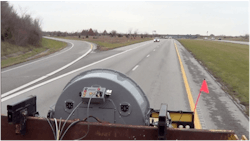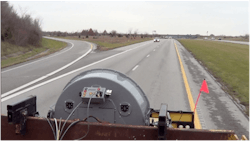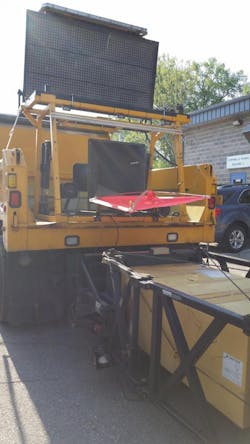Danger averted
Mobile work zones are used for many road-maintenance operations such as roadway striping, sweeping and minor pothole repair.
The Manual on Uniform Traffic Control Devices (MUTCD) includes some guidance for the layout of mobile work zones. A typical layout involves the use of shadow vehicles, arrow boards and signs to help alert travelers of the mobile work zone. A truck-mounted attenuator (TMA) is attached to the rear advanced-warning truck to serve as a buffer in case of a collision from a highway vehicle.
Given the speed differential between the mobile work zone and highway traffic, there is the potential for an inattentive traveler to be surprised by the mobile work zone. The increasing use of smart phones and other devices that are distracting drivers also has increased the need for additional methods to alert travelers that they are approaching a mobile work zone. A mobile work-zone alarm could be one possible counter-measure. This research presents the first field test of mobile work-zone alarms in the U.S. The purpose of the research was to evaluate the systems and provide guidance to departments of transportation.
Field of view looking back from video camera mounted on TMA with DAS.
Device types
As part of this project, two types of devices that are attached to the TMA were evaluated: an alarm device and a directional audio system (DAS). The alarm device has been used in the field by the Missouri Department of Transportation (MoDOT) by manual activation in which the TMA driver visually estimates the distance to trailing vehicles by using the number of skips on the lane striping as a reference. The driver first triggers warning lights when there is a vehicle within 1,040 ft in the TMA lane. If the highway vehicle continues to approach the TMA vehicle without showing any signs of merging, the TMA driver will trigger the alarm sound when the vehicle is within 520 ft of the TMA vehicle. For alarm activations, an actuated system also was tested for both the alarm device and DAS.
The alarm systems were tested in various operating modes. Five configurations were tested. The alarm device was tested in actuated and manual modes. The DAS was tested in actuated and continuous modes. Finally, a control configuration with no alarm system was used. There were several components to the evaluation including sound-level testing, spectral analysis to investigate the distinctiveness of the alarm sounds, analysis of merging distances and speeds, and observations of driving behavior. The actuated and manual activation methods also were evaluated for false alarms and false negatives. These investigations provided insight into the effectiveness of the alarm systems and helped to develop recommendations for improvements to the systems.
Out in the field
Three separate field tests were conducted. The purpose of the first field test, held near Columbia, Mo., on Rte. DD, was to perform preliminary tests on the DAS Actuated and Alarm Manual configurations without traffic and make adjustments to the various systems. The second test took place on a 10-mile section of I-70 west of Columbia. This test included field measurements under traffic. However, there were suboptimal conditions during the test, including equipment issues and traffic queuing, that ultimately led to the exclusion of the data collected at this site. In addition, there were not many merges near the TMA because the TMA was on the outside lane, and many vehicles changed lanes while approaching the shadow vehicle, which was set approximately 1 mile upstream from the mobile work zone.
The final field test took place in the Kansas City area on I-435 from Cookingham Drive to Shoal Creek Parkway. This segment had a total length of 12.5 miles including 5.5 miles of six-lane freeway and 7 miles of four-lane freeway. The AADT for this roadway was approximately 21,534 (2012) with 14% trucks. For this test, the TMA was on the median lane, which led to a greater number of merges near the TMA.
Sound-level testing
Various tests were used to determine if the sound levels were in accordance with standards established by the Occupational Safety and Health Administration (OSHA) and National Institute for Occupational Safety and Health (NIOSH). Sound-level tests were performed for both systems in a parking lot at various distances from both inside and outside of a vehicle. Sound levels were also measured from inside the TMA vehicle to analyze worker sound exposure. The results from the tests indicated that the sound levels were in accordance with standards established by OSHA and NIOSH except for the extreme case of standing 3 ft directly behind the unit for an extended period of time, a situation all but impossible in a moving work zone. Finally, sound levels were measured in the field inside instrumented vehicles before and after the alarm sounded. From these tests, it was determined that the sound levels inside the vehicle did not increase significantly when the alarm sounded.
Evaluating alarm distinction
In addition to the sound-level tests, the alarm sounds were evaluated for distinctiveness through the use of spectral analysis. The results of the spectral analysis indicated that the DAS produced a more distinctive sound that was better able to overcome background road noise than the alarm device. Driving behavior was the main measure of warning-system effectiveness in increasing mobile work-zone safety. Factors such as average speed, standard deviation of speed, average merging distance, standard deviation of merging distance and other observed driving behaviors were analyzed. These measures were used as surrogate safety measures for this study since the short test deployments precluded crash analysis.
The Safe Stopping Sight Distance (SSD) from the AASHTO Green Book was used as the definition for desirable driving behavior. SSD represents the smallest distance a vehicle could stop safely assuming a conservative deceleration rate and perception/reaction time. SSD was calculated as 600 ft from the TMA vehicle for a 60-mph speed differential. Therefore, desirable driving behavior was defined as merges that occurred at distances greater than 600 ft from the TMA vehicle. Using the 600-ft threshold, each vehicle’s merge distance was measured, and vehicle merges that occurred within 600 ft were further analyzed for average vehicle speeds and driving behavior observations.
A speaker for an alarm device mounted on a VMA.
Results
The results for merging distances and speeds are shown in Table 1. The results for average merging distance indicate that all configurations resulted in an increase in merging distance except for the Alarm Actuated configuration. The greatest improvement in average merge distance was with the DAS Continuous configuration, which resulted in a 31% increase from 392 ft to 514 ft. The standard deviation of merge distance and average speed were observed to decrease only in the DAS Continuous configuration, indicating that this configuration may be the most effective for improving mobile work-zone safety.
However, some occasional undesirable driver behaviors were observed with the DAS configurations. Instances in which some drivers had sudden reactions, such as braking or swerving, were observed with the DAS Actuated configuration. It is unclear whether these behaviors were due to the actuation of the mobile work-zone alarm. While the DAS Continuous configuration was in operation, some drivers were observed passing the TMA on the shoulder, giving the TMA an additional amount of space while passing. MoDOT personnel have indicated that drivers sometimes pass the TMA on the shoulder during routine operations, so this behavior may not be due to the presence of the mobile work-zone alarm.
False alarm and false negative statistics were used to evaluate the actuated and manual alarm-activation methods. By using the audio data with merging speeds and distances, each vehicle merge was evaluated as either a successful alarm activation, successful negative, false positive or false negative. The false alarm rate was calculated as the number of false alarms divided by the total number of activation events for the Control, Alarm Manual, Alarm Actuated, and DAS Actuated configurations. The Control configuration was able to measure false alarms because it had the actuation system running in the background and therefore recorded data for alarm activations. The DAS Continuous configuration also had the actuation system running in the background, but the actuation system was not running properly to collect any data. The false alarm rates were as follows: Control (31%), Alarm Manual (53%), Alarm Actuated (69%), and DAS Actuated (62%). Horizontal curves and movement of the TMA appeared to be the most likely causes of false alarms. False alarms for the Alarm Manual configuration were likely due to the TMA driver being cautious and sounding the alarm earlier than intended. The false-negative rate was calculated as the number of missed alarm activations divided by the number of merges that occurred within the threshold distance. The false-negative rates were as follows: Control (57%), Alarm Manual (13%), Alarm Actuated (54%), and DAS Actuated (26%). The most likely causes of false negatives appeared to be both horizontal and vertical curves.
Is this feasible?
The research demonstrated that mobile work-zone alarms have the potential to be an effective tool in improving safety by warning drivers. The DAS Continuous configuration provided the greatest benefits based on merging distance, standard deviation of merging distance and merging speeds. In determining which system to use, agencies should consider a variety of factors such as performance, cost and maintenance requirements.
Since this project was an initial test to investigate the feasibility of mobile work-zone alarms, further refinements to the systems, such as modifications to the alarm sound or warning message, could improve system effectiveness. Some recommendations for the actuated system include reducing false alarms and false negatives by narrowing the band of actuation and performing horizontal and vertical curve-tracking. Road segments containing horizontal and vertical curves were the most problematic for the actuated system. ST
Acknowledgments
The authors acknowledge the assistance provided by Andy Hanks, Chris Redline, John Russell, Tom Blair, Julie Stotlemeyer and others from MoDOT. The authors also would like to thank the following research assistants: Yi Hou, Pedro Ruiz, Jon Batchelor, Dylan Hackman and Zack Osman.


